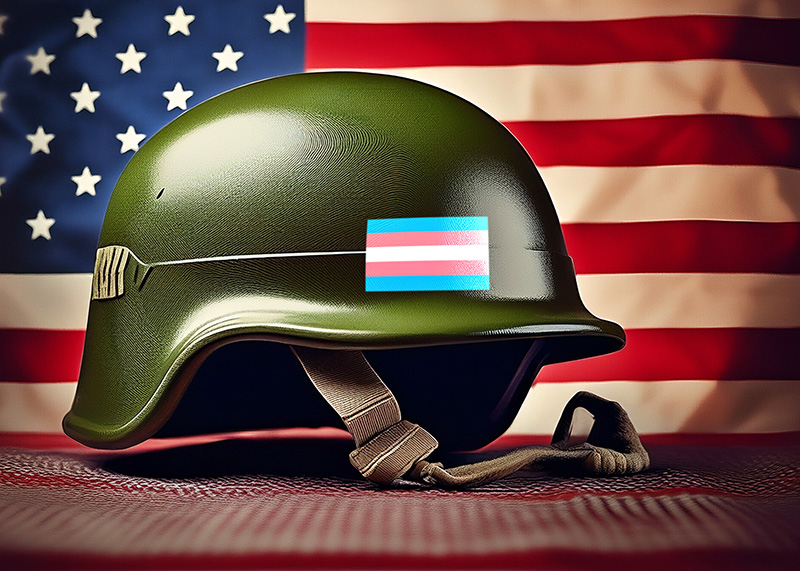Survey shows significant disparities exist between transgender people and overall population
Rates of harassment, poverty and suicidal ideation are significantly greater among transgender people

The results of a recently released national survey of transgender people show that transgender individuals lag behind their American counterparts for nearly every economic, health or social indicator, and are more likely to experience poverty, harassment and violence because of their gender identity.
Released on Thursday, the 2015 U.S. Transgender Survey polled 27,715 respondents from all 50 states, Washington, D.C. and U.S.-owned territories during the summer of 2015 and asked them about various aspects of their experiences as a transgender American. Unsurprisingly, as past surveys and studies of the community have shown, transgender Americans are more likely to face significant hardships and experience mistreatment than the general population.
“This survey is really going to help people understand transgender people and our lives,” Mara Keisling, the executive director for the National Center for Transgender Equality, said in a conference call with reporters.
“Over the past decade or so, we’ve made undeniable strides in visibility and acceptance. We’ve seen surveys that show that the percentage of people who have met a transgender person has risen in recent years, from under 10 percent, to now, about one-third of the population. … And undeniably, our policy agenda has advanced at rocket speeds and has done a lot of good,” Keisling said. “But the findings of this survey make it really crystal clear that there’s more work to do. The challenges facing transgender people and the tragedies that happen every day are just unacceptable and a significant social problem.”
Among the most shocking results contained in the survey are the high levels of mistreatment or harassment aimed at transgender individuals, significantly higher incidences of poverty and unemployment, and a greater number of transgender people who have attempted suicide.
On the discrimination front, 46 percent of respondents were verbally harassed and 9 percent were physically attacked because they were transgender. In the workplace, nearly one-third of respondents reported being fired, denied a promotion or experiencing some form of verbal or physical harassment at work.
Those who were out as transgender as children or teenagers reported higher instances of mistreatment at the hands of peers, teachers or administrators in school. Fifty-four percent of those respondents said they had been verbally harassed in school, with nearly one-quarter saying they were physically attacked, and 13 percent saying they were sexually assaulted, because of their gender identity. For 17 percent of respondents, the harassment was so bad it lead them to drop out of school.
The survey also shows that the unemployment rate for transgender people is 15 percent, three times greater than the overall unemployment rate for the general population. Among transgender people of color, the percentage of those who are unemployed climbs to 20 percent. Thus, it was not shocking to see higher rates of poverty and homelessness among the transgender population compared to the U.S. population. Nearly one-third of transgender people currently live in poverty, compared to 14 percent of the overall population. Another one-third have experienced homelessness at some point in their lifetime. Home ownership was extremely low among transgender respondents: only 16 percent reported that they owned their own home, compared to 63 percent of the general population.
The statistics don’t get much better for health outcomes, either. Thirty-nine percent of respondents reported experiencing “serious psychological distress” in the month prior to the survey, nearly eight times greater than the 5 percent rate among the general population. Similarly, 2 out of every 5 transgender respondents (40%) have attempted suicide in their lifetime, more than nine times the rate for the general population (4.6%). One-third reported having a negative experience with a health care provider because of their gender identity, and nearly one-quarter said they avoided seeking regular medical treatment because of fears of discrimination. Another one-third said they did not go to a health care provider when they needed because they could not afford it.
Only 11 percent of respondents reported that all of their IDs matched their preferred name and gender identity, while 68 percent said none of their IDs or vital documents matched either. The biggest hindrance to changing that information was the high cost of changing their legal name or updating their gender. As a results, people whose IDs did not match their gender presentation were more likely to be harassed, assaulted, or denied benefits or services.
Nearly 1 in 5 transgender people reported not using public accommodations in the past year because of fear of mistreatment. Thirty-one percent overall said they had experienced some type of mistreatment at a place of public accommodation in the past year, with 24 percent reporting verbal harassment and 14 percent said they were denied equal treatment or service as a result of their gender identity.
Nearly 1 in 10 respondents reported that someone denied them access to a restroom over the past year. And 12 percent reported being verbally harassed when they used a public restroom. To avoid that discomfort, 59 percent of transgender people have avoided using public restrooms, with 31 percent saying they limited the amount they ate or drank to avoid using the restroom. Eight percent reported having a urinary tract infection, kidney infection, or other kidney-related problems as a result of their avoidance of public restrooms.
Yet another 18 percent of transgender people reported that a medical professional had attempted to stop them from being transgender when they sought treatment for dealing with their gender identity, and 14 percent said their family had sent them to a medical professional to try and stop them from being transgender. Not surprisingly, these people were statistically more likely to report experiencing psychological distress, attempting suicide, running away from home, being homeless, or engaging in survival sex.
Sandy James, the lead author of the survey, said that the data could be used to better educate the public and policymakers about the transgender community and the issues they face that need to be addressed. James hopes the findings will prompt a dialogue about how best to resolve some of those issues.
Keisling said that much of the media coverage of transgender rights has centered around the use of public restrooms, often to the exclusion of of the other issues that were highlighted in the survey’s findings, such as economic inequality and the problems of accessing affordable, culturally competent health care.
“The bathroom conversation we’re having with America, I don’t think it’s a conversation anybody wanted to have, but we are having it. But every minute we spend talking about it, we’re not talking about the problems in real people’s lives,” she said. “We’re not talking about economic marginalization, or the real inability to get a career going. We’re not talking about people being alienated from their faith communities and from their families.
“The bathroom attacks that are happening against trans people aren’t about bathrooms to us. They’re about our ability to be human beings in this society. They’re about our dignity, just the everyday ability to go about your life,” she added. “[But] We have a lot of issues, like everybody else, about paying our rent, about taking care of our families, about walking our dogs, that are missed when all we talk about is bathrooms.”
Support Metro Weekly’s Journalism
These are challenging times for news organizations. And yet it’s crucial we stay active and provide vital resources and information to both our local readers and the world. So won’t you please take a moment and consider supporting Metro Weekly with a membership? For as little as $5 a month, you can help ensure Metro Weekly magazine and MetroWeekly.com remain free, viable resources as we provide the best, most diverse, culturally-resonant LGBTQ coverage in both the D.C. region and around the world. Memberships come with exclusive perks and discounts, your own personal digital delivery of each week’s magazine (and an archive), access to our Member's Lounge when it launches this fall, and exclusive members-only items like Metro Weekly Membership Mugs and Tote Bags! Check out all our membership levels here and please join us today!



























You must be logged in to post a comment.